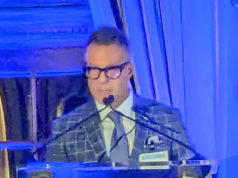
Jan S. Brunkwall, MD, from the University of Cologne in Cologne, Germany, delivered the Roy Greenberg Distinguished Lecture at the 2022 Vascular Annual Meeting (VAM), telling attendees “more is less, and less is more!” when it comes to treatment for aortic disease.
“After many years with open surgery, the endovascular technique came into our armamentarium,” he began his talk before the VAM 2022 gathering (June 15–18), before presenting attendees with a visual conundrum.
The late Roy Greenberg, of the Cleveland Clinic, died in December 2013 at the age of just 49, of cancer. He was known for his innovations and research, particularly in complex aortic disease, and for embracing endovascular surgery. He also was known worldwide as a teacher, mentor and researcher. According to published reports, he was issued nearly 100 patents on endovascular therapy on the basis of his research.
Brunkwall, who spent time with Greenberg during a previous role in Malmo, Sweden, in 1998, showed a video of a young boy skillfully conquering the use of chopsticks as an eating utensil. “For the older ones of you, I put this question: Can you all manage to eat with chopsticks? Can you treat all aneurysms endovascularly?” said Brunkwall. “For the younger ones, maybe this is quite natural, like for this little boy here.” As the video continues, the boy, now emboldened, is depicted confidently pushing on with the chopsticks—before floundering: “A hybrid solution is sometimes better,” Brunkwall concluded to audience laughter.
His Greenberg Lecture focused on abdominal aortic aneurysms (AAAs), juxtarenal AAAs and type B aortic dissections (TBAD).
Part of his message delved into the hot topic of AAA case volumes and training, emphasizing the importance of high-volume centers to adequate trainee caseload. “I ask you to have less aortic centers than you maybe have [currently],” said Brunkwall. “Because learning is crucial, and so is training. It goes for everybody—for tennis players, for artists, for Formula 1 drivers, air pilots. Why doesn’t [this] go for surgeons?”
Shortly before giving the lecture, Brunkwall explained in an interview with Vascular Specialist@VAM: “My presentation will highlight that endovascular treatment is less invasive than open surgery, and therefore the preferred option for many patients. However, a key factor is the impact of case volume load; high volume centers are associated with results whereas less experience tracks to more complications and more deaths. Another important consideration that is quite obvious but not adhered to by everybody is that strict compliance with instructions for use (IFU) yields better results, and I will illustrate this using examples.”
During the lecture, open surgery was forefronted as a “very” durable option and good solution for juxtarenal AAAs and AAAs, avoiding more extensive endovascular procedures.
Touching on acute TBAD treatment, Brunkwall maintained that endovascular treatment is less invasive and has better results with respect to mortality and devastating complications, such as paraplegia, than open surgery.
Again, sticking within the IFU will deliver long lasting results, he said, pointing out some examples of endovascular treatments that should never have been on the market. “Less humble means more trouble,” he said, referencing these procedures.












